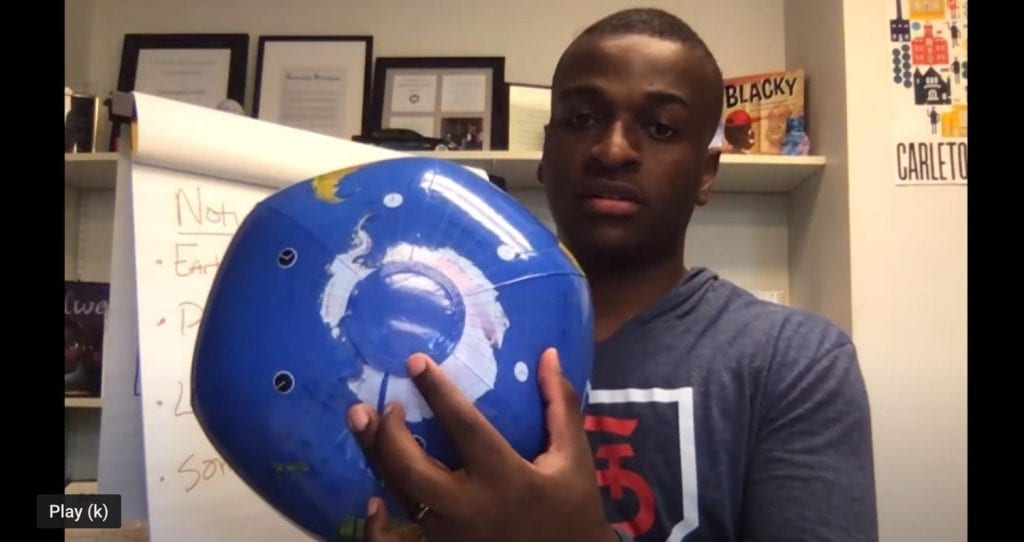When the coronavirus pandemic shut down schools in March, it highlighted the widening digital divide for many families and students in the St. Louis region. Schools and families struggled to quickly pivot to remote learning – lacking reliable internet and access to computers. Public television has become a key tool to keep students engaged and learning.
Since April 2020, the Institute for School Partnership at Washington University in St. Louis has partnered with the St. Louis PBS station Nine Network (KETC/Channel 9) to create and produce on-air math and science classroom lessons through the “Teaching in Room 9” series. The program provides daily literacy and math episodes and weekly science and social studies instruction free of charge.
“The truth is that while not every home has a computer and Internet, most homes have a television.” ISP executive director Victoria L. May explains. “The curriculum is purposefully low-tech. This partnership is a good option to get high-quality instruction to students.”
The ISP recruited a diverse group of educators from ISP partner schools to teach the science episodes and provide materials – from science kits to recording equipment.
The ISP’s mySci and Math314 instructional specialists coach and consult with teachers and producers to develop the grade-specific science and math lessons. Each episode is aligned with state and national math and science standards ensuring students have access to rigorous learning regardless of their situation at home.

Chris Frills, founder and principal of KIPP Wonder Academy, who teaches the second-grade science episodes, says the resources provided by the ISP have been amazing.
“Any random thing I need they provide,” he says. “The operation and logistics behind the scenes are great, so shout out to the ISP.”
Leveraging Relationships
For more than three decades, the ISP has worked with a diverse population of K-12 schools and students. Building those trusted relationships with St. Louis area educators has made the ISP a backbone organization in the region. ISP also works with business leaders, foundations and organizations to connect educators with resources and opportunities through programs such as STEMpact. As leaders looked to ISP for ways to support students and teachers, STEMpact stepped up to provide financial support for “Teaching in Room 9” as part of their longstanding commitment to STEM educational equity.
“Partnerships are at the heart of the way we work,” says May. “These strong and long standing relationships were in place before the crisis, and have just grown from there, widening the impact of our work.”
The ISP delivers science curriculum to over 300 regional schools and districts and provides more than 100,000 students and 3,800 teachers access to high quality STEM teaching and learning through innovative programs.
According to the Missouri Department of Elementary and Secondary Education, public schools statewide, lost 888,815 students during the pandemic, concentrated at the lower grade levels. Educators and school leaders looked to the ISP for strategies to reach students. This past fall, over 100,000 viewers in the St. Louis region tuned-in to “Teaching in Room 9” science lessons.
The ISP has worked tirelessly to provide equitable STEM education opportunities and resources to students across the region. May says “Teaching in Room 9” has been a purposeful way to reach students during these challenging times.
Gardens and living rooms, ponds, parks, and empty classrooms have become the backdrop for these 30-minute episodes. There have been cameos by dog friends Wayne and Oliver Hargrove, a stuffed animal, and even other children.
Teachers on TV: Region’s Largest Classroom


Jeanne Norris, an ISP instructional specialist who creates the third-grade videos, calls this TV teaching endeavor “a dream come true.” She has turned her videos into a family affair, often including her third-grade son.
“We’ve gotten to wear bee suits, fossil hunt, and play with puppies,” she says.
“I have been a scientist all of my life. And guess what? So have you,” says Nisreen Newby, as she peers into the screen from her desk in her empty classroom.
“I want the student viewers to love exploration! I try to emphasize how amazing our world is and how much we can learn from it,” says Newby, a first-grade teacher in The School District of University School. “My favorite part is being able to use my creativity. I am not limited to a classroom so I can explore outside, take pictures, tell stories and so much more!”
Newby is grateful to the ISP for this digital teaching experience and for supporting her throughout the journey.
“I can go to them for anything and their encouragement has helped me be more confident in my role as I cover these standards and use their materials,” she says.
“Did you enjoy doing that clock yoga?”Julia Knarr, a second-grade teacher, with The Soulard School, asks as she exhales a deep breath, wrapping up a mindfulness exercise that has students making a clock with their bodies.
Knarr was one of the math teachers given instructional support by Math314 instructional specialists Jeff Kennedy and Wendy LaRose.
“I could not have done it without you,” she said of their support services.
Stay Tuned
The ISP and STEMpact are committed to KETC’s “Teaching in Room 9,” with new episodes airing Monday through Friday.
“We remain focused on our goal to reach, teach and empower students and teachers,” says May.
The “Teaching in Room 9” episodes can be found on Nine Network’s YouTube channel after they air on TV.
Media Contact: Myra Lopez